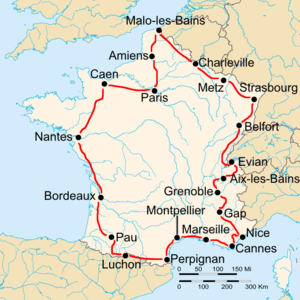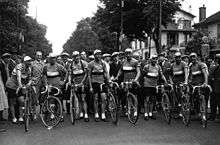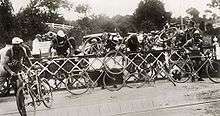1932 Tour de France
 | |||
| Route of the 1932 Tour de France Followed counterclockwise, starting in Paris | |||
| Race details | |||
|---|---|---|---|
| Dates | 6–31 July | ||
| Stages | 21 | ||
| Distance | 4,479 km (2,783 mi) | ||
| Winning time | 154h 11' 49" | ||
| Results | |||
| Winner | (France) | ||
| Second | (Germany/Austria) | ||
| Third | (Italy) | ||
| Team | Italy | ||
The 1932 Tour de France was the 26th edition of the Tour de France, taking place from 6 to 31 July. It consisted of 21 stages over 4,479 km (2,783 mi).
André Leducq, who also won six stages, won the race, thanks to the bonification system; had the bonification system not existed, the margin between Leducq and Kurt Stöpel had only been three seconds.[1]
Changes from the previous Tour
In the 1931 Tour de France, there had been a time bonification system, which gave 3 minutes of bonification to the winner of the stage, if he finished more than three minutes ahead of the second cyclist in that stage.[2] In 1932, this bonification system changed: now the winner of the stage received 4 minutes, the second-placed cyclist 2 minutes and the third-placed cyclist 1 minute, plus an extra three minutes if the margin was more than three minutes.[3][4] The bonification system was invented to give sprinters, who lost a lot of time in the mountains, a chance to battle for the general classification.[5]
The number of stages decreased from 24 to 21. The total distance also decreased, so the average length per stage remained about the same, 215 km (compared to 160–170 km in modern Tours).[6]
Teams

For the third year, the race was run in the national team format, with five different teams. Belgium, Italy, Switzerland and France each sent a team with eight cyclists, while Germany and Austria sent a combined team, with seven German cyclists and one Austrian cyclist. In addition, 40 cyclists joined as touriste-routiers.[4]
Charles Pélissier, who had won 13 stages in the 1930 and 1931 Tours, and Antonin Magne, the winner of 1931, were absent from the French team. Still, there were so many good French cyclists in that time that the French team was still considered superior.[6]
The Italian team included three Giro d'Italia winners: the winner from the 1930 Giro d'Italia, Luigi Marchisio; the winner from the 1931 Giro d'Italia, Francesco Camusso and the winner from the 1932 Giro d'Italia, Antonio Pesenti.[6]
The Belgium team had Jef Demuysere, who had fought for the victory in the previous Tour until the end and had become second, and two-time world champion Georges Ronsse.
Race overview

In the first stage, the Belgians had a good start. Jean Aerts won the stage, with Jef Demuysere in second place. In the second stage, there were struggles in the Belgian team between the Dutch-speaking and the French-speaking cyclists.[6] Aerst, Dutch-speaking, did not get the support from his French-speaking team mates, and lost ten minutes in that stage, together with the Italian favourites.[6] German Kurt Stöpel won the stage, and donned the yellow jersey, thanks to the bonification. Stöpel was the first German cyclist to lead the general classification in the Tour de France.[1] In the third stage, the longest stage of this Tour with 387 km, Stöpel lost the lead to André Leducq. Leducq kept the lead for the rest of the race, winning six stages along the way. In the fifth stage, Spanish Vicente Trueba escaped and reached the top of the Col d'Aubisque first. On the way down, Benoît Fauré overtook him, and reached the Tourmalet first. But he didn't win the stage, as Italian Antonio Pesenti caught him. Behind the leaders in the stage, Leducq was fighting for the leading position in the general classification. He was not a good climber, but was one of the best descenders.[7]
On one stage, Leducq flatted, and received a wheel from his team mate Georges Speicher, who would win the next Tour.[6]
In the tenth stage, Leducq almost lost the lead. Camusso had escaped, and Stöpel had followed him. Leducq lost more than five minutes in the stage, and even more due to the bonification time.[7] After that stage, Stöpel was within three minutes of Leducq, and Camusso within six minutes.[7] In the eleventh stage, Leducq could have lost the race. Benoît Fauré, a French cyclist riding as a touriste-routier, escaped, and was followed by Francesco Camusso. At one point, they were so far ahead that Camusso was the virtual leader, but eventually they were caught back.[6]
Leducq also crossed the finishline first in the eighteenth stage, but the jury relegated him because he had been pushed by Albert Barthélemy.[6]
Leducq and Stöpel finished in the same group for most of the stages. Only in four stages was there a time difference:[1][8]
- Stage 3, when Leducq won 45 seconds
- Stage 5, when Leducq won 20 seconds
- Stage 10, when Stöpel won 2 minutes and 52 seconds
- Stage 13, when Leducq won 1 minute and 50 seconds
Without the bonification system, the time difference between Leducq and Stöpel was three seconds. Leducq received 31 bonification minutes (six first places, two second places and three third place), while Stöpel received only 7 bonification minutes (one first place and three third places).
Results
The cyclist to reach the finish in the least time was the winner of the stage. The time that each cyclist required to finish the stage was recorded. For the general classification, these times were added together. If a cyclist had received a time bonus, it was subtracted from this total; all time penalties were added to this total. The cyclist with the least accumulated time was the race leader, identified by the yellow jersey.
The team classification was calculated by adding up the times in the general classification of the three highest ranking cyclists per team; the team with the least time was the winner.
Stage winners
| Stage | Date | Course | Distance | Type[n 1] | Winner | Race leader | |
|---|---|---|---|---|---|---|---|
| 1 | 6 July | Paris to Caen | 208 km (129 mi) | | Plain stage | | |
| 2 | 7 July | Caen to Nantes | 300 km (190 mi) | | Plain stage | | |
| 3 | 9 July | Nantes to Bordeaux | 387 km (240 mi) | | Plain stage | | |
| 4 | 11 July | Bordeaux to Pau | 206 km (128 mi) | | Plain stage | | |
| 5 | 12 July | Pau to Luchon | 229 km (142 mi) | | Stage with mountain(s) | | |
| 6 | 14 July | Luchon to Perpignan | 322 km (200 mi) | | Stage with mountain(s) | | |
| 7 | 16 July | Perpignan to Montpellier | 168 km (104 mi) | | Plain stage | | |
| 8 | 17 July | Montpellier to Marseille | 206 km (128 mi) | | Plain stage | | |
| 9 | 18 July | Marseille to Cannes | 191 km (119 mi) | | Plain stage | | |
| 10 | 19 July | Cannes to Nice | 132 km (82 mi) | | Stage with mountain(s) | | |
| 11 | 21 July | Nice to Gap | 233 km (145 mi) | | Stage with mountain(s) | | |
| 12 | 22 July | Gap to Grenoble | 102 km (63 mi) | | Stage with mountain(s) | | |
| 13 | 23 July | Grenoble to Aix-les-Bains | 230 km (140 mi) | | Stage with mountain(s) | | |
| 14 | 24 July | Aix-les-Bains to Evian | 204 km (127 mi) | | Stage with mountain(s) | | |
| 15 | 25 July | Evian to Belfort | 291 km (181 mi) | | Stage with mountain(s) | | |
| 16 | 26 July | Belfort to Strasbourg | 145 km (90 mi) | | Plain stage | | |
| 17 | 27 July | Strasbourg to Metz | 165 km (103 mi) | | Plain stage | | |
| 18 | 28 July | Metz to Charleville | 159 km (99 mi) | | Plain stage | | |
| 19 | 29 July | Charleville to Malo-les-Bains | 271 km (168 mi) | | Plain stage | | |
| 20 | 30 July | Malo-les-Bains to Amiens | 212 km (132 mi) | | Plain stage | | |
| 21 | 31 July | Amiens to Paris | 159 km (99 mi) | | Plain stage | | |
| Total | 4,479 km (2,783 mi)[11] | ||||||
General classification
Kurt Stöpel was the first German to reach the podium of the Tour de France.[3] He would be the only German on the podium until Jan Ullrich became 2nd in 1996.
| Rank | Rider | Team | Time |
|---|---|---|---|
| 1 | | France | 154h 11' 49" |
| 2 | | Germany/Austria | + 24' 03" |
| 3 | | Italy | + 26' 21" |
| 4 | | Italy | + 37' 08" |
| 5 | | Belgium | + 41' 04" |
| 6 | | Belgium | + 45' 13" |
| 7 | | Germany/Austria | + 58' 44" |
| 8 | | Belgium | + 1h 03' 24" |
| 9 | | Touriste-routier | + 1h 06' 57" |
| 10 | | France | + 1h 08' 37" |
| Final general classification (11–57) | |||
|---|---|---|---|
| Rank | Rider | Team | Time |
| 11 | | Switzerland | + 1h 13' 33" |
| 12 | | Touriste-Routier | + 1h 14' 12" |
| 13 | | Belgium | + 1h 16' 24" |
| 14 | | Italy | + 1h 18' 45" |
| 15 | | Belgium | + 1h 19' 18" |
| 16 | | France | + 1h 25' 27" |
| 17 | | Touriste-Routier | + 1h 29' 21" |
| 18 | | Touriste-Routier | + 1h 35' 28" |
| 19 | | Germany/Austria | + 1h 38' 23" |
| 20 | | Belgium | + 1h 39' 01" |
| 21 | | Touriste-Routier | + 1h 45' 56" |
| 22 | | Germany/Austria | + 1h 49' 48" |
| 23 | | France | + 1h 55' 27" |
| 24 | | Touriste-Routier | + 1h 56' 53" |
| 25 | | France | + 1h 58' 16" |
| 26 | | Italy | + 1h 59' 47" |
| 27 | | Touriste-Routier | + 2h 00' 40" |
| 28 | | Touriste-Routier | + 2h 22' 21" |
| 29 | | Switzerland | + 2h 24' 39" |
| 30 | | France | + 2h 29' 02" |
| 31 | | Touriste-Routier | + 2h 29' 31" |
| 32 | | Touriste-Routier | + 2h 30' 12" |
| 33 | | Italy | + 2h 35' 51" |
| 34 | | Belgium | + 2h 41' 25" |
| 35 | | Touriste-Routier | + 2h 44' 33" |
| 36 | | Switzerland | + 2h 59' 37" |
| 37 | | Touriste-Routier | + 3h 04' 31" |
| 38 | | Touriste-Routier | + 3h 10' 27" |
| 39 | | Germany/Austria | + 3h 15' 13" |
| 40 | | Touriste-Routier | + 3h 32' 25" |
| 41 | | Switzerland | + 3h 34' 06" |
| 42 | | Touriste-Routier | + 3h 38' 18" |
| 43 | | Touriste-Routier | + 3h 43' 20" |
| 44 | | Touriste-Routier | + 3h 55' 22" |
| 45 | | Touriste-Routier | + 4h 00' 17" |
| 46 | | Touriste-Routier | + 4h 06' 02" |
| 47 | | France | + 4h 13' 53" |
| 48 | | Touriste-Routier | + 4h 20' 41" |
| 49 | | France | + 4h 21' 05" |
| 50 | | Touriste-Routier | + 4h 21' 15" |
| 51 | | Touriste-Routier | + 4h 32' 29" |
| 52 | | Touriste-Routier | + 4h 38' 35" |
| 53 | | Touriste-Routier | + 4h 47' 05" |
| 54 | | Touriste-Routier | + 4h 47' 18" |
| 55 | | Switzerland | + 4h 54' 45" |
| 56 | | Germany/Austria | + 5h 03' 01" |
| 57 | | Germany/Austria | + 5h 05' 14" |
Team classification
| Rank | Team | Time |
|---|---|---|
| 1 | Italy | 464h 57' 41" |
| 2 | Belgium | + 7' 27" |
| 3 | France | + 11' 50" |
| 4 | Germany/Austria | + 38' 56" |
| 5 | Switzerland | + 4h 14' 25" |
Other classifications
The organing newspaper, l'Auto named a meilleur grimpeur (best climber), an unofficial precursor to the modern King of the Mountains competition. This award was won by Vicente Trueba.[13]
Aftermath
Winner André Leducq kept riding the Tour de France until 1938, but he never managed to win again,[6] although he had three more stage victories.[14]
Notes and references
Footnotes
- ↑ There was no distinction in the rules between plain stages and mountain stages; the icons shown here indicate which stages included mountains, and which were run as time trials.
References
- 1 2 3 4 Tom James (15 August 2003). "1932: A bonus for Leducq". Retrieved 30 September 2009.
- ↑ "25ème Tour de France 1931" (in French). Mémoire du cyclisme. Archived from the original on 6 March 2012. Retrieved 28 October 2016.
- 1 2 "The Tour - Year 1932". Amaury Sport Organisation. Retrieved 30 September 2009.
- 1 2 3 4 "26ème Tour de France 1932" (in French). Mémoire du cyclisme. Archived from the original on 29 August 2012. Retrieved 28 October 2016.
- ↑ Barry Boyce (2004). ""Le Joyeux DeDe" Returns to Form". Cycling revealed. Retrieved 30 September 2009.
- 1 2 3 4 5 6 7 8 9 McGann, Bill; McGann, Carol (2006). The Story of the Tour De France. dog ear publishing. pp. 104–108. ISBN 1-59858-180-5. Retrieved 2009-09-30.
- 1 2 3 "1932: André Leducq stelt in de Alpen zijn tweede Tourzege veilig" (in Dutch). Tourdefrance.nl. 19 March 2003. Retrieved 30 September 2009.
- ↑ "26ème Tour de France 1932 - 18ème étape" (in French). Mémoire du cyclisme. Archived from the original on 31 August 2012. Retrieved 28 October 2016.
- ↑ Historical guide 2016, p. 30.
- ↑ Arian Zwegers. "Tour de France GC Top Ten". CVCC. Archived from the original on 2009-05-04. Retrieved 2009-04-20.
- ↑ Historical guide 2016, p. 108.
- ↑ "Leducq, ganador definitivo, como se espereba, de la XXVI Vuelta a Francia" (in Spanish). El mundo deportivo. 1 August 1932. Archived from the original on 2009-10-02. Retrieved 2009-09-30.
- ↑ Michiel van Lonkhuyzen. "Tour-giro-vuelta". Retrieved 29 September 2009.
- ↑ "The tour - André Leducq". Amaury Sport Organisation. Retrieved 30 September 2009.
Sources
- Augendre, Jacques (2016). Guide historique [Historical guide] (PDF). Tour de France (in French). Paris: Amaury Sport Organisation. Archived (PDF) from the original on 17 August 2016. Retrieved 27 October 2016.
External links
![]() Media related to 1932 Tour de France at Wikimedia Commons
Media related to 1932 Tour de France at Wikimedia Commons